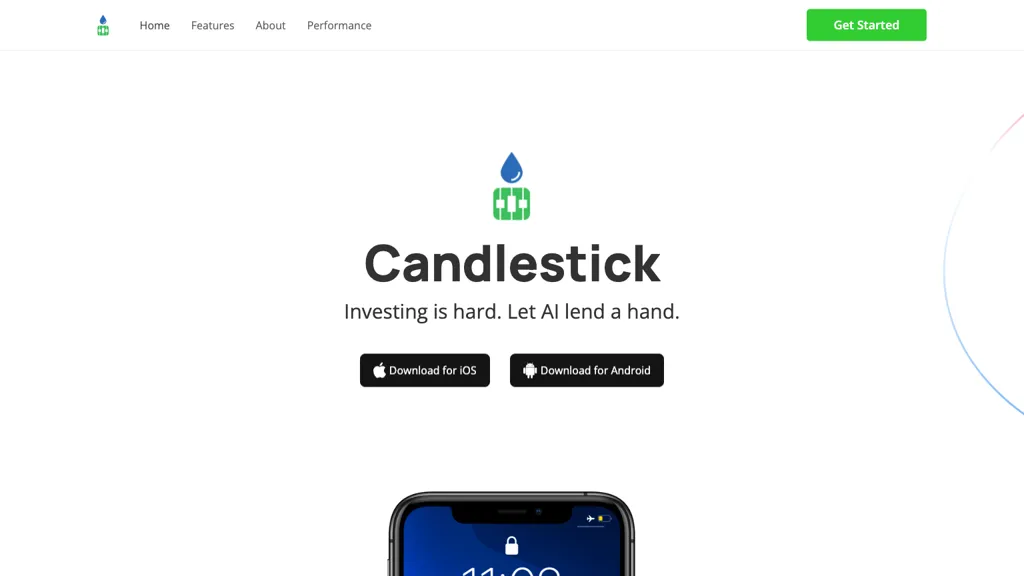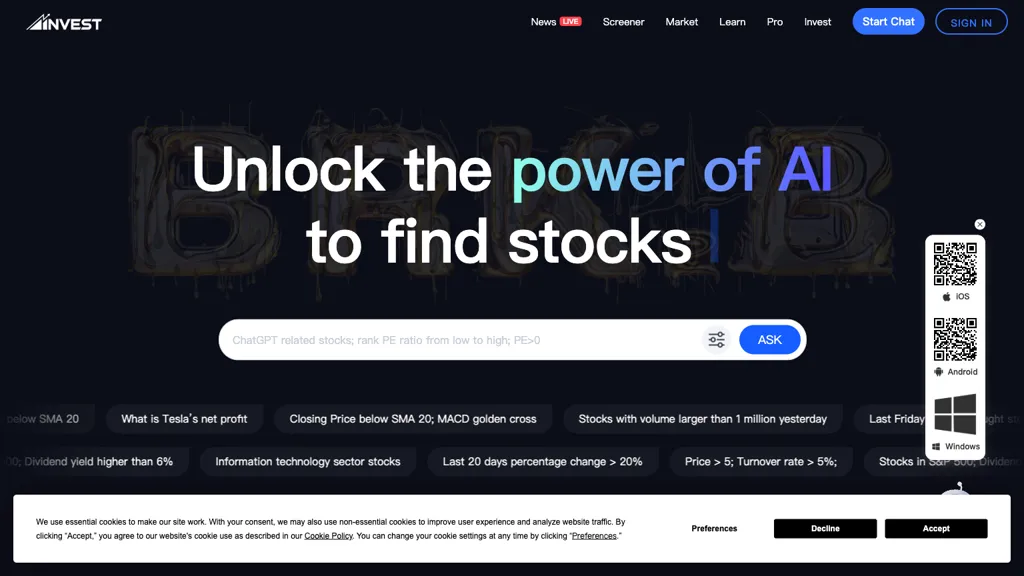Assessing the cost and pricing of AI analysis and stock prediction platforms is essential to ensure that you are getting the most value from your investment and avoid hidden charges or unanticipated expenses. Understanding what you are paying for and the pricing structure can be very different. This will help you make an informed decision. Here are the top ten tips to evaluate the price and cost of these platforms:
1. Learn Pricing Model
Subscription-based : Determine if there's a monthly fee or an annual cost and what features are included in each level.
Pay-per-use: Make sure the charges of the platform are based on usage for example, the number of trades (or request for data) or forecast.
Freemium model: Assess whether the platform has the free version with only a few features, and charges for premium features.
2. Compare Pricing Tiers
Compare the features of each price tier, e.g. Basic, Professional Enterprise, Basic.
Scalability: Ensure your pricing levels match your needs, regardless of whether you're an individual trader or professional.
Upgrade flexibility: Find out if you are able to easily upgrade or downgrade as your needs alter.
3. Evaluate Hidden Costs
Fees for data. Verify that the platform is charging a fee to access premium data.
Brokerage fees: Check if the platform charges additional fees for trade execution or integration with brokers.
API usage: Assess whether there are additional costs to access APIs or high-frequency API usage.
4. Assess Free Trials and Demos
Trial period: Search for platforms that offer the opportunity for a free trial or demo to test their features prior to committing.
Trial limitations: Determine if you can use all features included in the trial, or only one or a few.
Option to not commit If you aren't satisfied with the platform, you can cancel it without any charge.
5. Check out the latest discounts and special offers
Discounts for annual plans Find out whether you qualify for a discount on the annual plan, compared to the monthly.
Referral programs: Verify if you can get discounts or credits by referring others to the platform.
Find out about pricing for institutions If you're part of an organization with a lot of employees.
6. ROI (Return on Investment) How can you assess the ROI?
Cost vs. value - Decide if the platform's capabilities, features, and predictions are worth it. For example, does it assist you in making better trade decisions or help you save time?
Performance track record Review the platform's rates of success or user reviews to determine its ROI potential.
Alternative costs Consider comparing the cost of the platform to the potential cost of not using it (e.g., missed opportunities, time spent on manual analysis).
7. Review, Cancellation, and Refund Policies
Conditions for cancellation: Make sure that you can cancel your subscription without penalty or hidden charges.
Refund policy: Check whether the platform allows refunds on unused portions of your subscription.
Auto-renewal : Check if your subscription is automatically renewed by the platform and learn how to opt out.
8. Assess Transparency in Pricing
Clear pricing page: Ensure the platform provides a clear and detailed pricing page, with no fees hidden.
Customer Support: To clarify unclear pricing details and additional charges, call customer support.
Contract Terms: Read the conditions of service for any long-term agreements or penalties.
9. Compare yourself to your competition
Comparing features and prices on different platforms is a great method to ensure you're getting the best price.
User reviews: Study user feedback to see whether others think the platform is worth the investment.
Check the market positioning of the platform. Does it meet your requirements?
10. Cost estimates for Long-Term
Price increases: Find out whether and how often the platform increases its prices.
Additions to features: Check whether new features are included in your plan currently or need to be upgraded.
Scalability Costs: Make sure the pricing of your platform is reasonable as your trading activity or demands for data increase.
Bonus Tips
Test multiple platforms in a trial: Use several platforms with free trials to test their capabilities and effectiveness.
Negotiate pricing: If you're high-volume user or part of a larger institution, ask about discounts or custom pricing.
You can find educational free resources on some platforms.
Following these tips can assist you in evaluating the prices and expenses of AI software for predicting and analyzing stocks. It is possible to pick one that is suitable for your budget, while providing the features you need. A good platform price should be able balance the affordability of the platform with its performance. This will allow you to achieve maximum trading success. View the most popular ai investment platform for site info including ai investing, ai stock picker, incite, investing ai, best ai stock, ai trading, trading with ai, ai stock picker, incite, best ai trading app and more.

Top 10 Tips For Assessing The Risk Management Of Ai Stock Predicting Trading Platforms
Risk management is a crucial component of any AI trading platform that predicts or analyzes stocks that helps safeguard your capital and reduce the risk of losses. A platform with robust risk management tools can aid you navigate the market volatility and make well-informed decisions. Here are the top ten tips to assess the risk management capabilities of these platforms.
1. Evaluation of Stop-Loss and Take-Profit Features
Customizable levels - Make sure that the platform lets you customize your stop-loss, take-profit and profit levels for every strategy or trade.
Trailing stops: Check if your platform supports trailing stops that are automatically adjusted as the market moves to your advantage.
Guaranteed stops: Verify whether the broker offers guaranteed stop-loss orders, which guarantee that your position will be closed at the specified price regardless of market volatility.
2. Assessment Position Sizing Tools
Fixed amount: Check that the platform you are using allows you to set position sizes in accordance with a set amount.
Percentage of portfolio Manage your risk by establishing the size of your portfolio proportionally in terms of per percentage.
Risk-reward: Make sure your platform permits you to determine risk-rewards for each strategy or trade.
3. Make sure you have Diversification Support
Multi-asset trading. Make sure that your platform supports different asset classes like ETFs and Forex, Options, and Stocks.
Sector allocation: Check if the platform provides tools to monitor and manage the exposure of sectors.
Geographic diversification - Verify that the platform allows the ability to trade on markets across the world. This will help reduce geographical risks.
4. Examine the impact of leverage and margins
Margin requirements - Ensure that the platform clearly explains margin requirements clearly.
Find out if your platform lets you to set limits on leverage in order to manage the risk of exposure.
Margin call - Check to see if your service alerts you to margin calls in a timely manner. This will prevent liquidation.
5. Review the Risk Analytics Reporting
Risk metrics - Check that your platform has crucial risk metrics, such as the Sharpe ratio (or Value at Risk (VaR)), or drawdown (or value of portfolio).
Scenario analysis: Check whether the platform allows you to simulate various market scenarios in order to evaluate potential risks.
Performance reports: Verify whether the platform has comprehensive performance reports, which include the risk-adjusted return.
6. Check for Real-Time Risk Monitoring
Monitoring of your portfolio. Make sure your platform can track in real-time the risk associated with your portfolio.
Alerts: Make sure you receive real-time alerts for associated with risk (e.g. stop-loss triggers or margin breaches).
Check the risk dashboards. If you want to get a full picture of your risk, make sure they're customizable.
7. Assess the effects of stress testing and backtesting
Test your strategies for stress: Ensure that the platform you select allows you to test your strategies and portfolio under the most extreme conditions of the market.
Backtesting: Verify that the platform supports backtesting strategies based on previous data to assess risk and performance.
Monte Carlo simulations: Verify whether the platform utilizes Monte Carlo simulations to model a range of possible outcomes and determine the the risk.
8. Verify Compliance with Risk Management Regulations
Regulatory compliance: Ensure the platform is compliant with applicable regulation on risk management (e.g., MiFID II in Europe, Reg T in the U.S.).
Best execution: Ensure that the platform adheres the best execution methods. It will guarantee that transactions are completed according to the most competitive price in order to reduce loss.
Transparency: Make sure that the platform provides clear and transparent disclosures about risks.
9. Look for parameters controlled by the user.
Custom Risk Rules: Ensure that you are able to define your own rules for managing risk (e.g. the maximum amount of loss per day, or a maximum amount of tradeable position).
Automated risk control: Check whether the system can automatically enforce rules for risk management in accordance with your predefined parameters.
Manual overrides - Examine to see if the platform permits you to manually bypass automated risk control.
Review user feedback and case studies
User reviews: Examine feedback from users to assess the effectiveness of the platform in managing risk.
Case studies: Search for case studies, or testimonials, that prove the ability of the platform to manage risk.
Community forums: Check if the platform has an active user community where traders share risk management tips and strategies.
Bonus Tips
Trial period: Use the demo or trial version for free to test the features of the platform for risk management in real-world situations.
Customer support - Make sure that the platform offers a robust assistance for any questions or issues concerning risk.
Educational resources: Find out if there are any educational resources on best practices in risk management.
With these suggestions, you can evaluate the capability of AI platforms for stock prediction and analysis to control risk. This will help you pick a system that is safe for your investment and reduces any losses that could occur. It is essential to have robust risk-management tools in order to successfully navigate the volatile markets. Follow the recommended best ai for stock trading blog for site examples including ai software stocks, ai share trading, how to use ai for stock trading, chart ai trading, how to use ai for stock trading, best ai stocks to buy now, best ai stocks to buy now, stocks ai, ai stock investing, ai in stock market and more.
